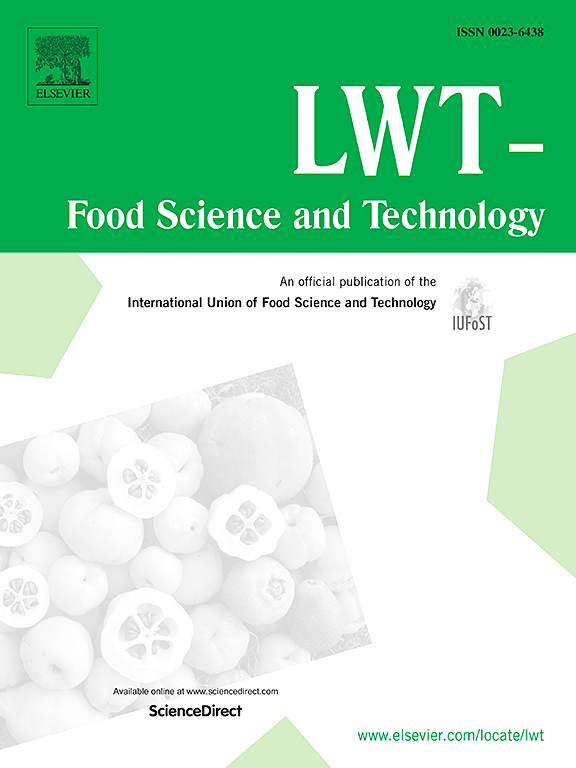Comprehensive analysis of oils and remaining solid matrices from supercritical fluid extraction of salmon side streams: Fatty acids, bioactive peptides, minerals, and heavy metals
IF 6
1区 农林科学
Q1 FOOD SCIENCE & TECHNOLOGY
引用次数: 0
Abstract
Atlantic salmon (Salmo salar) side streams (head, backbone, and viscera) are nutrient-rich and offer potential for valorization. This study evaluates supercritical fluid extraction (SFE) and solvent extraction (SE) methods for recovering oils, fatty acids, bioactive peptides, minerals, heavy metals, and antioxidants from these byproducts. Both the oil and the remaining solid resulting from the extraction process were analyzed. SFE was more effective in extracting fatty acids from heads and backbones. However, SE yielded a higher peptide content, with SE backbone solids containing 281 peptides, and SE viscera and heads containing 220 peptides each. In contrast, SFE-derived solids had significantly fewer peptides: 9 in heads, 129 in backbones, and 130 in viscera. The identified peptides exhibit potential functional properties, including antioxidant, anti-inflammatory, antithrombotic, immunomodulating, anticancer, and hypolipidemic effects. Mineral and heavy metal content in all extracts met safety standards. SFE-derived matrices had the highest calcium levels (49.7 mg/g in heads, 24.2 mg/g in backbones) and lower heavy metal concentrations than SE. Arsenic, cadmium, mercury, and lead levels were 1.8 mg/kg, 1.8 μg/kg, 55.0 μg/kg, and 25.7 μg/kg, respectively, for SFE, compared to SE's higher values (e.g., 3.5 mg/kg for arsenic). Both methods produced extracts with promising antioxidant activity.
综合分析油和剩余固体基质从超临界流体提取鲑鱼侧流:脂肪酸,生物活性肽,矿物质和重金属
大西洋鲑鱼(Salmo salar)的侧流(头部,脊柱和内脏)营养丰富,并提供潜在的价值。本研究评价了超临界流体萃取(SFE)和溶剂萃取(SE)两种方法从这些副产品中回收油脂、脂肪酸、生物活性肽、矿物质、重金属和抗氧化剂的效果。对萃取过程中产生的油和剩余固体进行了分析。SFE对头部和脊柱脂肪酸的提取效果较好。然而,SE的多肽含量较高,SE主干固体含有281条多肽,SE内脏和SE头各含有220条多肽。相比之下,sfe衍生的固体中肽含量明显减少:头部9个,脊柱129个,内脏130个。鉴定出的肽具有潜在的功能特性,包括抗氧化、抗炎、抗血栓、免疫调节、抗癌和降血脂作用。所有提取物中矿物质和重金属含量均符合安全标准。sfe衍生基质的钙含量最高(头部49.7 mg/g,脊柱24.2 mg/g),重金属浓度低于SE。SFE的砷、镉、汞和铅水平分别为1.8 mg/kg、1.8 μg/kg、55.0 μg/kg和25.7 μg/kg,而SE的数值更高(例如,砷为3.5 mg/kg)。两种方法提取的提取物均具有良好的抗氧化活性。
本文章由计算机程序翻译,如有差异,请以英文原文为准。
求助全文
约1分钟内获得全文
求助全文
来源期刊

LWT - Food Science and Technology
工程技术-食品科技
CiteScore
11.80
自引率
6.70%
发文量
1724
审稿时长
65 days
期刊介绍:
LWT - Food Science and Technology is an international journal that publishes innovative papers in the fields of food chemistry, biochemistry, microbiology, technology and nutrition. The work described should be innovative either in the approach or in the methods used. The significance of the results either for the science community or for the food industry must also be specified. Contributions written in English are welcomed in the form of review articles, short reviews, research papers, and research notes. Papers featuring animal trials and cell cultures are outside the scope of the journal and will not be considered for publication.
 求助内容:
求助内容: 应助结果提醒方式:
应助结果提醒方式:


